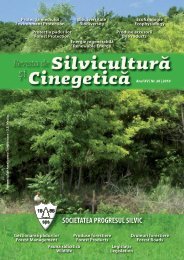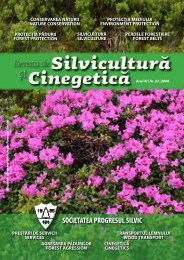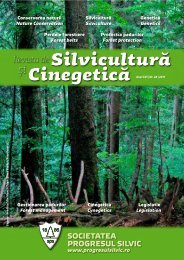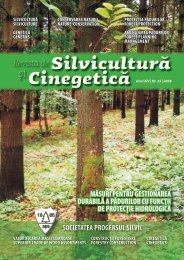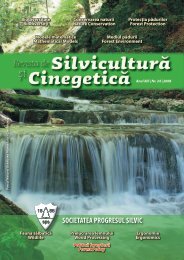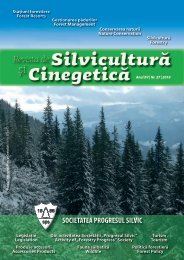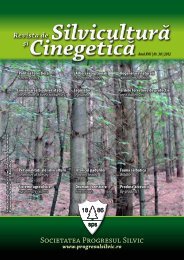Silviculture and Cinegetics Review - Societatea Progresul Silvic
Silviculture and Cinegetics Review - Societatea Progresul Silvic
Silviculture and Cinegetics Review - Societatea Progresul Silvic
Create successful ePaper yourself
Turn your PDF publications into a flip-book with our unique Google optimized e-Paper software.
FORESTRY BELTS SILVICULTURE AND CINEGETICS REVIEW XVII/30/2012<br />
In this situation the following composition is<br />
recommended: 40Stb 20Ult(Tea) 20Pă 20arb.<br />
VI. Areas with argic faeozioms <strong>and</strong> argic chernozems<br />
(luvic phaeozems <strong>and</strong> luvic chernozems – WRB – SR,<br />
1998) in the internal silvosteppe.<br />
In order to fit these areas into a ecological site<br />
framework it is recommended the following<br />
ecological site type: ”Internal silvosteppe, high<br />
productivity (Quercus pedunculiflora), argic<br />
faeozioms <strong>and</strong> argic chernozems on loessoid<br />
substratum, high edaphic volume, physiologically<br />
very deep, loamy to clayey-loamy soils, moderate<br />
humus content.<br />
Recommended composition: 40Stb 20Tea(Ju) 20Pă<br />
20arb.<br />
VII. Areas with typical preluvosols (haplic luvisols –<br />
WRB – SR, 1998), reddish preluvosols (chromic<br />
luvisols), reddish luvosols (chromic luvisols), typical<br />
luvosols (haplic luvisols) <strong>and</strong> albic luvosols (albic<br />
luvisols) from the forest plain.<br />
These areas can be framed in the following ecological<br />
forest site type: ”Forest plain, medium-high<br />
productivity (Quercus pedunculiflora, Quercus<br />
robur), typical preluvosols, reddish preluvosols,<br />
reddish luvosols, typical luvosols <strong>and</strong> albic luvosols<br />
on loamy or clayey-loamy substratum (± loessoid),<br />
physiologically very deep, high edaphic volume,<br />
loamy to clayey-loamy texture, low to moderate<br />
humus content”.<br />
According to this type of ecological forest site, the<br />
recommended composition is the following: 40Stb(St)<br />
20Pa(Tea) 20Cd 20arb.<br />
VIII. Areas with vertic preluvosols (vertic luvisols –<br />
WRB – SR, 1998) <strong>and</strong> reddish-vertic preluvosols<br />
(vertic-chromic luvisols) in complex with argic-vertic<br />
phaeozioms (verti-luvic phaeozems), vertic luvosols<br />
(vertic luvisols), albic-vertic luvosols (verti-albic<br />
luvisols), typical <strong>and</strong> vertic planosols (haplic <strong>and</strong><br />
vertic planosols) <strong>and</strong> vertosols (vertisols) on clayed<br />
substratum (± loessoid) in the forest plain<br />
The type of ecological site that fits these areas is<br />
”Forest plain, medium-low up to low productivity<br />
(Quercus cerris, Quercus frainetto), vertic preluvosols<br />
<strong>and</strong> reddish-vertic preluvosols in complex with argicvertic<br />
phaeozioms, vertic luvosols, albic-vertic<br />
luvosols, typical <strong>and</strong> vertic planosols <strong>and</strong> vertosols on<br />
clayed substratum (± loessoid), physiologically<br />
medium deep, with high edaphic volume, clayey<br />
texture, moderate humus content, compact to very<br />
compact soils”.<br />
Recommended composition: 40Ce(Gî) 30Pă 30arb.<br />
The significance of symbols used for the<br />
recommended forest species in the afforestation<br />
composition is the following: St – Quercus robur,<br />
Stb – Quercus pedunculiflora, Stp – Quercus<br />
pubescens, Ce – Quercus cerris, Gî – Quercus<br />
frainetto, Tea – Tilia tomentosa, Ju – Acer campestre,<br />
Pa – Acer platanoides, Ult – Ulmus pumila, Sl –<br />
Eleagnus angustifolia, Mj – Fraxinus ornus, Pă –<br />
Pirus pyraster, Cd – Prunus cerasifera, arb – shrubs.<br />
Setting up these types of soil <strong>and</strong> ecological forest site<br />
situations is being done by taking into consideration<br />
the principle of mutual partial compensation of the<br />
ecological factors.<br />
The presented afforestation solutions are basic<br />
solutions for establishing the forest shelterbelts in the<br />
Danube Plain <strong>and</strong> Dobrogea.<br />
For practical considerations, alternative solutions are<br />
required, which should be adopted only in the<br />
following situations:<br />
- lack or insufficient quantity of seedlings required by<br />
the basic solution, in the situation in which the<br />
execution stage is due to start soon;<br />
- decision (in case of state-owned l<strong>and</strong>s) or expressed<br />
wish (in case of privately-owned l<strong>and</strong>s) to benefit as<br />
quickly as possible from the protective effect of the<br />
shelterbelts.<br />
For the alternative solutions the main recommended<br />
species are black locust (on the noncarbonatic soils in<br />
the forest plain <strong>and</strong> in the sylvosteppe) <strong>and</strong> honey<br />
locust (on the carbonatic soils in the sylvosteppe <strong>and</strong><br />
steppe). The species that are part of these alternative<br />
solutions should be chosen by taking into<br />
consideration the following criteria: quick growth,<br />
abundance of afforestation material, as well as the<br />
drought resistance. These main species shall be<br />
accompanied by other species such as: Turkestan elm,<br />
nettle tree, cherry plum, Russian olive, shrubs.<br />
3.2. Establishing the necessary of forest shelterbelts<br />
<strong>and</strong> network location on l<strong>and</strong> use categories<br />
(arable or pasture)<br />
As previously mentioned the field forest shelterbelts<br />
network resulted from overlapping the theoretical<br />
model (600 m x 1200 m) over the surface already<br />
vectorized of the two categories of agricultural l<strong>and</strong><br />
under study (arable l<strong>and</strong> <strong>and</strong> pastures).<br />
Therefore is resulted the forest shelterbelts network<br />
corresponding to the two l<strong>and</strong> use categories <strong>and</strong><br />
55



